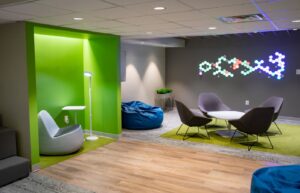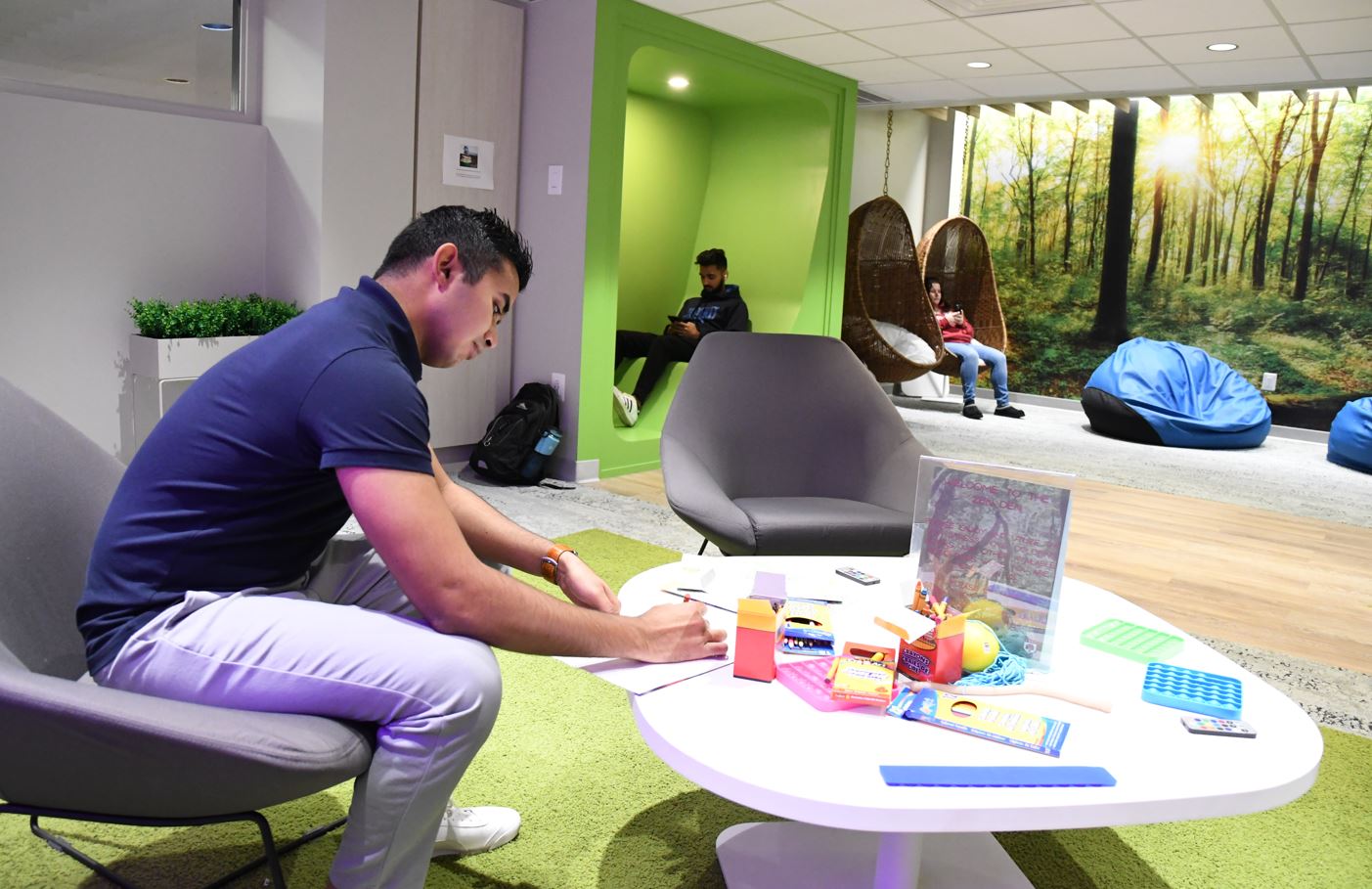Caption: At Rider University, an underutilized computer lab in the Bart Luedeke Center (BLC) was identified as a prime candidate for renovation. Photo Credit: Spiezle
By John F. Wright, AIA, LEED AP BD+C
Student centers have always been a place of prominence on the collegiate campus, but in recent years the focus on their capability and responsibility to provide a wide array of social, physical and mental support services has heightened greatly. As architects design the next generation of higher education student-centered buildings, the primary goal should be crafting spaces where individuals can feel supported and welcome. In addition to the common pressures and outside influences that every student encounters, mental health challenges on college campuses are a reality that students face more often. The American Psychological Association’s peer-reviewed journal “Stigma and Health” published a recent article showing how struggles with mental health are linked to college students performing worse academically and being more likely to drop out. It is the responsibility of architects to approach design opportunities in a holistic manner to create spaces that consider both students’ physical and mental health so that their individuality and creativity can thrive while they grow as learners.
Fortunately, over the last few years, more colleges and universities are emphasizing a comprehensive approach to student health and transforming on-campus spaces to empower students to rest, rejuvenate, and connect through an array of recreation and engaging options. Architects and college administrators can—and should—continue to partner with student representatives and groups to ensure that these places meet the needs of the current and future generations of learners and elevate their mental health, creativity and academic outcomes.
At Rider University in Lawrenceville, N.J., campus administrators, facilities leaders and the student government have a strong history of collaboration on projects. As the need continued to escalate for spaces to support neurodivergent students and the demands of elevated stress levels, an underutilized computer lab in the Bart Luedeke Center (BLC) was identified as a prime candidate for renovation. Working together, the initial vision evolved into the concept of creating a relaxation lounge. Dubbed the Zen Den, the space is the culmination of an inclusive process where the design team conducted focus-group meetings with the students and staff to explore their needs and select the features that would craft a welcoming environment, spark creativity and remove the excess “noise” of the busy campus beyond its walls. This former tech-heavy space has transformed into a peaceful venue where students can put devices down and engage in calm, healthy activities while mentally recharging.
A crucial role of the Zen Den is supporting neurodivergent students, many of whom struggle with feelings of overstimulation and need a break from technology as well as being surrounded by a bustling campus community. However, rather than a blank room with white walls where sensory input is removed, Spiezle designed the Zen Den so that students can interact with its features, such as textured surfaces and light patterns that create warm colors when touched. Light-based therapy tools such as touch lights in different colors and brightness have demonstrated benefits for neurodivergent individuals.

Photo Credit: Spiezle
Other interactive elements of the Zen Den include hanging chairs, which allow students to experience sensory input through gentle swinging movements they control themselves. Beanbag chairs and built-in alcove lounge seating provide soft, comforting options for rest and mental recharge in either a group or individual setting. The variety of options allows each visitor to shape their personal experience in the space and adjust it to their specific needs.
The Zen Den also features biophilic design elements, which aim to reduce anxiety while increasing cognitive function and restoring a depleted attention span by bridging the divide between inside environments and the natural world outside. Covering an entire wall, a sunlit forest mural mimics the natural world—offering a chance for students to recenter through peaceful contemplation.
In addition to offering a blend of relaxation and healthy recreation, student centers must also be places where students can focus on their physical health. Studies have demonstrated a correlation between physical activity and mental wellness for college students, and recreation centers can be a crucial part of that mission. This is especially true for elite intercollegiate athletics.
The National Institutes of Health reports that with the vast spread of name, image, and likeness (NIL) income opportunities for student-athletes, pressure to choose the “right” school—and then maintain their success in athletics so that endorsements don’t dwindle—presents a constant concern. Add to this the normal academic pressures of completing assignments on time and achieving good grades. Amid such constant stressors, student athletic centers should be imagined as places where those pressures fade away. Biophilic elements are as welcome in a sports training facility for their calming aspects as they are in student relaxation areas. Neutral or other less-obtrusive colors for walls also create welcoming and tranquil spaces.
Making positive architectural design choices in wellness spaces also helps colleges attract and retain top talent, especially as more students are opting for trade schools or vocational training over the traditional four-year college path. At the same time, student-athletes have a wider range of options when choosing where to enroll, and a wellness-focused athletic center can be a key factor in their decision—particularly when it reflects a broader institutional commitment to comprehensive physical and psychological well-being.
Atlantic Cape Community College (ACCC) in Hamilton, N.J., has developed a master plan for its athletics department to boost its competitive appeal. ACCC’s efforts include maintaining gender parity across all sports programs, expanding offerings to engage more students and attract additional candidates, modernizing physical education buildings and facilities, and embracing a more personalized, supportive approach to physical and mental health. This consistent level of support fosters a strong sense of purpose in student-athletes, which translates into school spirit and a shared commitment to team sports. As a result, colleges can experience reputational gains and increased student interest in institutions that truly prioritize student wellbeing.
A student-first approach is critical for designing campus student centers and wellness spaces. College administrators, architects, and design teams collectively have an excellent opportunity to engage students to plan and build campuswide amenities that drive mental and physical fitness. Whether a college builds something new or renovates an outdated venue, students expect and deserve holistic resources on campus. A collaborative process between architects, campus leadership, and student groups leads to positive outcomes that support more sustainable student growth and development while driving a school’s recruitment and long-term success.
John Wright, AIA, LEED AP BD+C, is a principal at Spiezle. He can be reached at jwright@spiezle.com.


